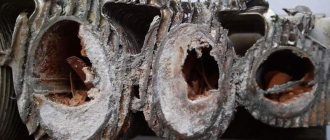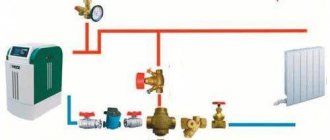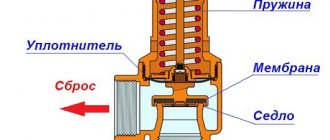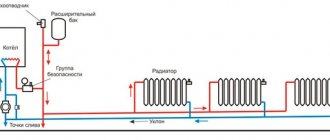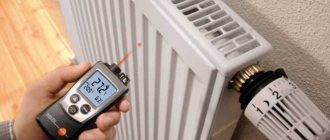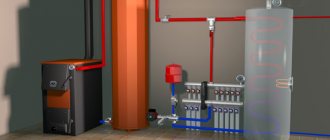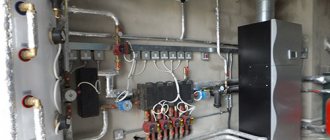As an advertisement
Double-circuit boiler equipment, solar systems and heat pumps appeared, and plastic pipes, taps and connections began to be used as materials. Installation of the system has become simpler, more convenient and more accessible for “non-professionals”; it is easier to configure and repair. The usual solution has been the use of “warm floors” based on circulation pipelines.
All these innovations led to the development of another technical solution: the use of non-freezing liquids - coolants in individual heating systems of private houses.
The use of coolants raises many questions, speculations and disputes. Some stereotypes have already formed a practice of application, which sometimes looks comical. Therefore, in this article, specialists from the OBNINSKORGSINTEZ company, Heat Transfer Fluids department, will answer the most common questions.
To use or not to use antifreeze liquid as a coolant?
There is no GOST or standard that requires the mandatory use of a coolant or prohibits its use. Sometimes there are designs for industrial systems that require the use of “water-glycol solutions,” and if you turn to heating equipment manufacturers, they also do not have a single general solution - some prohibit them altogether, others allow the use of certain brands of coolants. Which decision is correct?
The answer to this question can be obtained by taking into account a combination of many factors: this is the equipment model, the type of structure, the mode of its use, the material and insulation of the walls, the type of system, and the region of location. But the most important factor is the degree of security of the system in unforeseen, emergency cases.
eddiki
I made my own heating system for the first time in my life using metal-plastic, there are no leaks in the fittings. The argument in favor of antifreeze was given by the specialist who started my boiler - antifreeze has its drawbacks, but the main thing is to preserve the system in any force majeure. According to him, last winter a lot of COs died on the water for various reasons. I have propylene glycol, -20, the system works, and I sleep peacefully when I’m not at the dacha.
It's no secret that the main task of the coolant is to protect the system from defrosting and damage in case of unforeseen situations. And there are quite a lot of situations when a house can be left without heating for a long time:
- long-term departure of the whole family, when there is no one to heat the house;
- seasonal use of a summer house or house;
- Finally, no one is immune from gas pipeline accidents or long-term power outages, which have become common in winter after freezing rains that cut power lines.
In such conditions, the use of non-freezing liquid is an absolutely justified solution.
Which one to choose, how do they differ?
Serg3515
A lot has been written and rewritten on this topic, but I have never seen a clear answer (and preferably from a user with experience). In this regard, if I may ask some questions. So, after all, what to fill in? (what kind of non-freezing liquid). Electric boiler, two-pipe system, metal-plastic pipes.
For an uninitiated person, understanding the abundance of offers and the price range can be very difficult.
The key factor in choosing a coolant is its basis, i.e. basic chemical raw materials. The following are traditionally used as a basis:
- ethylene glycol is a toxic dihydric alcohol;
- propylene glycol is a non-toxic substance acceptable for use in the food industry.
The second selection criterion is the additives used in the coolant. There are organic additives (carboxylate) and inorganic. Additives affect the service life and quality of the coolant. Coolant with organic additives has a longer service life and, during operation, more reliably protects the system from corrosion.
The third indicator is how heating equipment manufacturers treat this product; in other words, whether a particular coolant is acceptable for use in a system where this type of equipment is used.
Rating of coolants based on a combination of quality characteristics:
- Coolant based on propylene glycol with organic additives and approvals from equipment manufacturers. This coolant provides the widest range of indicators: environmental friendliness and safety, service life, physical and chemical properties, and versatility of use, from kindergarten to food production.
- Coolant based on ethylene glycol with organic additives and approvals from equipment manufacturers. Such a coolant already has limitations in its use. You can determine its purpose: industrial facilities and systems that are reliably isolated from human activity.
- Coolant based on propylene glycol with conventional inorganic additives. Although such a product has a shorter service life, it is harmless enough to be around people and animals.
- Coolant based on ethylene glycol with inorganic additives. Poisonous, short service life. Its use is often driven by the need to save money. If the system is well isolated from contact with human life, such a solution is quite logical.
PS Coolant based on glycerin. Glycerin is the simplest trihydric alcohol, which is a viscous transparent liquid, also used as a food additive. The product has high density, kinematic and dynamic viscosity. Equipment manufacturers provide indicators several times lower than those present in glycerin-based coolant. The product has no operational or physical advantages, although it is quite easy to produce, which is why it is inexpensive. European manufacturers of chemical compounds have a very negative attitude towards the use of glycerin as a base for antifreeze liquids.
Characteristics of non-freezing liquids for heating
How low-freezing liquid for heating systems behaves in the circuit is primarily influenced by the quality of the additive package and, of course, operating conditions. Regardless of what main active element is added to the glycol base, all compositions have anti-corrosion and anti-foaming properties.
Without these additives, heating fluid is very aggressive. All antifreezes foam, but glycerin antifreeze liquids for home heating systems especially. Foam is an air-containing substance, and air leads to disruption of circulation, the formation of air pockets, as well as water hammer in the heating system.
The additive package has its own temporary resource. After a certain time, additives break down at the molecular level.
In this case, a precipitate forms and acid is released. It turns out that nothing can smooth out the aggressiveness of the coolant for heating the house, and moreover, everything is aggravated by the release of acid. Service life of antifreeze liquid:
- based on ethylene glycol – five years;
- based on propylene glycol – five years;
- glycerin-based - up to ten years.
This is the service life of the composition under favorable operating conditions. The main requirement is, of course, temperature. When the coolant temperature rises to 90 degrees, the non-freezing liquid begins to disintegrate and loses its properties. This only happens if the boiler is not started correctly after a long period of inactivity, or if there are errors during installation.
Direct contact of the heat exchanger with the flame is undesirable if antifreeze is poured into the circuit
For example, when a heat exchanger is built into a conventional oven. Some install it so that it comes into contact with an open flame. If you plan to use antifreeze for stove heating, then you cannot do this. It is necessary that there is a layer of brick between the heat exchanger and the flame. It will protect the coolant from too hot flames and distribute the heat evenly. In this case, the non-freezing liquid for stove heating will not overheat.
Characteristics that are affected by the quality of the additive package:
- thermal conductivity;
- density;
- viscosity;
- fluidity;
- thermal expansion.
The better the additives, the higher the performance will be. That is, as close as possible to the characteristics of water. In the case of the coefficient of thermal expansion, it should be as small as possible.
Considering the fact that the volumetric expansion of the antifreeze is greater than that of water, it is necessary to provide an expansion chamber with a 40% larger volume.
The thermal conductivity of antifreeze is lower than that of water. Glycerin antifreeze liquids have the lowest thermal conductivity. In relation to water, it is only 85%; for other anti-freeze products the figure can reach 90%. As you can see, the difference is not that big.
Antifreeze liquids are half as dense and viscous as water. These qualities make circulation difficult. To pump the coolant through the circuit, you will need a pump of greater power, and it would also be a good idea to assemble a heating circuit from pipes with a cross-section that is one step larger. For example, if we are talking about polypropylene pipes, then instead of 25 in diameter, it is better to take 32.
Despite the fact that antifreeze liquid is denser and more viscous, it has a lower surface tension coefficient, that is, it is more fluid. Do you know that you can fill a glass with heaps of water? The slide, of course, will be small, but even visually it can be seen that the liquid rises above the edge of the vessel. This won't work with anti-freeze. Due to such high fluidity, it flows out where water does not penetrate due to surface tension. In other words, if there are microcracks and even very small holes, then the non-freezing liquid will find its way out there.
Therefore, often, after there was water in the circuit and they decided to pour anti-freeze into it, leaks appear. Main leak points:
- pipe joints;
- connections between radiator sections;
- connection points for additional elements;
- in the boiler itself.
Water has another useful property, thanks to which a minor leak can disappear by itself. Metal particles settle on the edges of cracks and seal them. Of course, this is just scale, which, if the system is flushed and further pressure tested, will be removed and the flow will resume.
Should I dilute with water or not?
The origin of this issue is due to the fact that equipment manufacturers set the same requirements, worrying about the safest and most efficient operation possible. Buyers stick to their line, driven by the need to save money. And coolant manufacturers maneuver between the requirements of manufacturers, buyers and sales practices. As always, the truth is somewhere in the middle.
Manufacturers of antifreeze liquids mainly offer “-65C” or “-30C” coolants to the market. Firstly, this is due to established demand, and secondly, such a coolant is guaranteed not to be frozen at the time of sale.
Equipment manufacturers have their own truth. Thus, the density of non-freezing liquid marked “-25C”, mainly recommended by equipment manufacturers for reasons of optimal fluidity, is 1.03 g/cm3, and that of liquid “-30C” is 1.04 g/cm3.
The fact that the content of the main substance in the coolant will be several percent higher is not an “exorbitant” deviation, but taking into account the fact that water can be “added” to the coolant either when recharging the circuit, or if water is not completely drained from the system after flushing , a “reserve” of concentration is simply necessary.
On the other hand, diluting the coolant from “-30C” to “-25C” - and this value is 3-4% - will not bring tangible savings to the buyer, but will increase the risk of losing other necessary properties. But in the case when the buyer plans to use concentrated coolant “-65C” and dilute it, the savings can already be up to 20%.
What is the service life, how do you know: when to replace?
The question is quite common.
Andreic
Experts, clarify the situation: today contractors said that antifreeze has a validity period of 5-7 years. Then it loses its properties, begins to precipitate, and generally does not flow through the heating system as it should. True or not?
For coolants that contain organic (carboxylate) additives, the service life is 10 seasons (10 years), for coolants with “ordinary” silicate additives, this period is about 5 years (heating seasons). In order to control quality, every year, after the end of the heating season, you can carry out a simple procedure - pour a small amount of coolant into a transparent glass container. The resulting sample is visually inspected for the presence of mechanical and other impurities, color, and transparency. If the coolant contains mechanical impurities (crumbs, grains of scale), it can be drained, filtered, flushed the system and refilled. If there are traces of chemical changes (flakes, clots), you need to contact a specialist.
In what systems can antifreeze liquid be used?
There are a number of restrictions on the use of antifreeze:
- Antifreeze liquid, regardless of its chemical composition, can only be used in a closed circuit. This means that there is constant pressure in the system, circulation is constantly forced, due to the pump.
- Coolants are not used with electrolysis-type electric boilers. Electrolysis type is when the coolant is used as an electrical conductor. The electrical conductivity of coolants is low, and this will lead to high energy costs.
- Antifreeze liquids must not be used in contact with galvanized surfaces (pipes).
How to add antifreeze to your home heating system
A country house or dacha, where the owners come to relax on weekends, is heated periodically during the winter. Therefore, the question of whether to pour antifreeze or water into the heating system of such a home is not subject to discussion. To prevent defrosting of equipment and pipes, they must be filled only with non-freezing liquid.
| Monday | Open 24 hours |
| Tuesday | Open 24 hours |
| Wednesday | Open 24 hours |
| Thursday | Open 24 hours |
| Friday | Open 24 hours Now open |
| Saturday | Open 24 hours |
| Sunday | Open 24 hours |
How to decide on the required temperature, or is -30C too much or too little?
Application practice shows that the temperature in a room that has not been heated for a long time and the ambient temperature are always different. The room will always be warmer - by 10 degrees or more. Even if it’s minus 40 outside the window, and the room is frozen to minus 30, the coolant will not turn into ice and, accordingly, will not burst pipes and radiators. In order for antifreeze labeled -30C to freeze and damage the heating system, the temperature (in the house) must be below -50C, which in reality is quite difficult to imagine.
Rash98
For three seasons I have been using propylene glycol as antifreeze in a natural circulation system. Everything works perfectly. The batteries heat up after just 10 minutes. I use propylene glycol not concentrated, but diluted to the freezing point of minus 30 degrees. S. Flooded once three years ago.
On the other hand, non-freezing liquids with temperatures of minus 10, 15 and even 20C should not be used for a number of reasons:
- Even in the central regions of Russia in winter the temperature drops below these values. In such conditions, it is unlikely that anyone will want to buy a product that has turned into “snow porridge”, despite the fact that after thawing it will completely return to its properties.
- At the slightest dilution (which is very likely, especially in double-circuit boilers, or after flushing the system), the coolant without a small temperature margin will lose its necessary properties.
Heating system requirements
So, as already indicated, if you plan to use antifreeze as a coolant, this should be taken into account at the design and installation stage, but it should also be taken into account that these compounds are used exclusively in closed systems.
In addition, it must be taken into account that:
- forced circulation will also be mandatory, since it will not be possible to ensure the required speed of coolant transportation due to its higher viscosity and density;
- it will be necessary to introduce a complete ban on the use of pipes and connecting elements made of zinc;
- special attention will have to be paid to all connections - it is not allowed to use tow and oil-based paint for this, since the aggressive environment of the composition will simply destroy them;
If the heating system is planned to be operated with a non-freezing coolant, then there are some requirements for the boiler equipment - it must have a control system with which it will be possible to maintain the temperature level, since for some types of coolants of this group the threshold of 65- 75 °C is unacceptable. Attention should also be paid to the circular pump, especially if the system is being converted from water to antifreeze: the power of the old one is simply not enough, even with the same circulating volume. You will also need an expansion tank with a larger volume, approximately 1.5-2 times. The diameter of the pipes will also have to be increased, as well as radiators with an increased volume installed.
If the autonomous heating system is equipped with an electrode electric boiler, then the use of antifreeze must comply with the recommendations of the equipment manufacturer. This is due to the fact that heating of the coolant occurs due to the passage of alternating current through it, therefore the qualitative composition of the antifreeze is very important - it must have the required density and provide the necessary electrical resistance.
Antifreeze mixtures, as a rule, are sold ready to be poured into the system, but if for some reason, for example, antifreeze is designed for a maximum temperature of -40 ° C, and the maximum in winter rarely exceeds -20 ° C - in this case it can be diluted, but only with distilled water. But all the same, if there is a question about using antifreeze in the heating system, then even in mild winters you should still focus on -30 °C.
When there was water in the system, everything was fine, they filled in the coolant and all the connections started leaking.
Arnau
It's time to decide what to fill the heating system in a country house with: distilled water or antifreeze.
The main argument against antifreeze is that it corrodes connections, leaks are possible and components need to be changed frequently.
Indeed, non-freezing liquids are more fluid than water. And fluidity increases with increasing temperature. They do not contain chemical compounds that, by forming calcium deposits, can clog microgaps. Even if the microgaps become clogged with something, coolant additives will “clean” the clogged formations and restore the leak. Therefore, more attention must be paid to the assembly of joints in a system where it is planned to use antifreeze. And, as mentioned earlier, before starting it is necessary to carry out commissioning work, including pressure testing of the system.
Why do many people refuse water?
If you are faced with the question of what to put into the heating system of a private house for the winter, then most likely you will have to give up water. In this case, a coolant parameter such as temperature plays an important role. If the temperature in the building drops below 0 °C, the liquid will freeze and this will cause a breakdown of the heating system.
